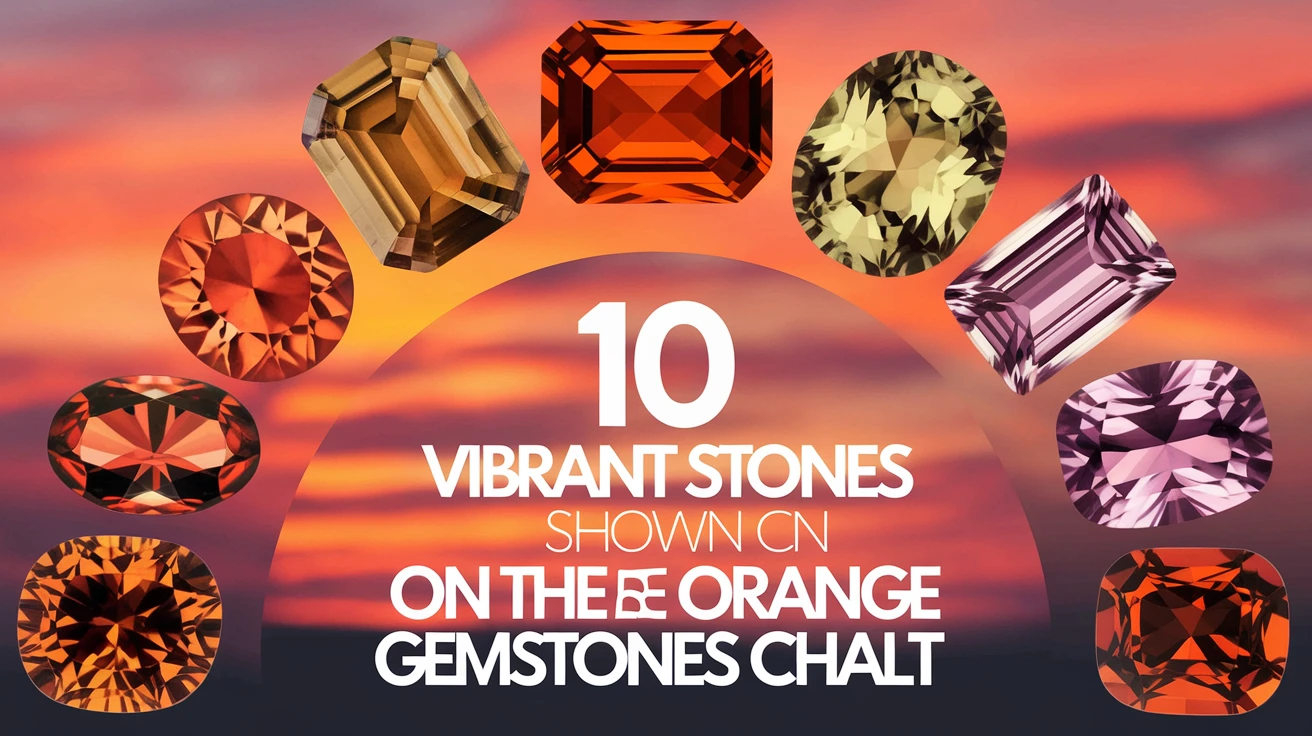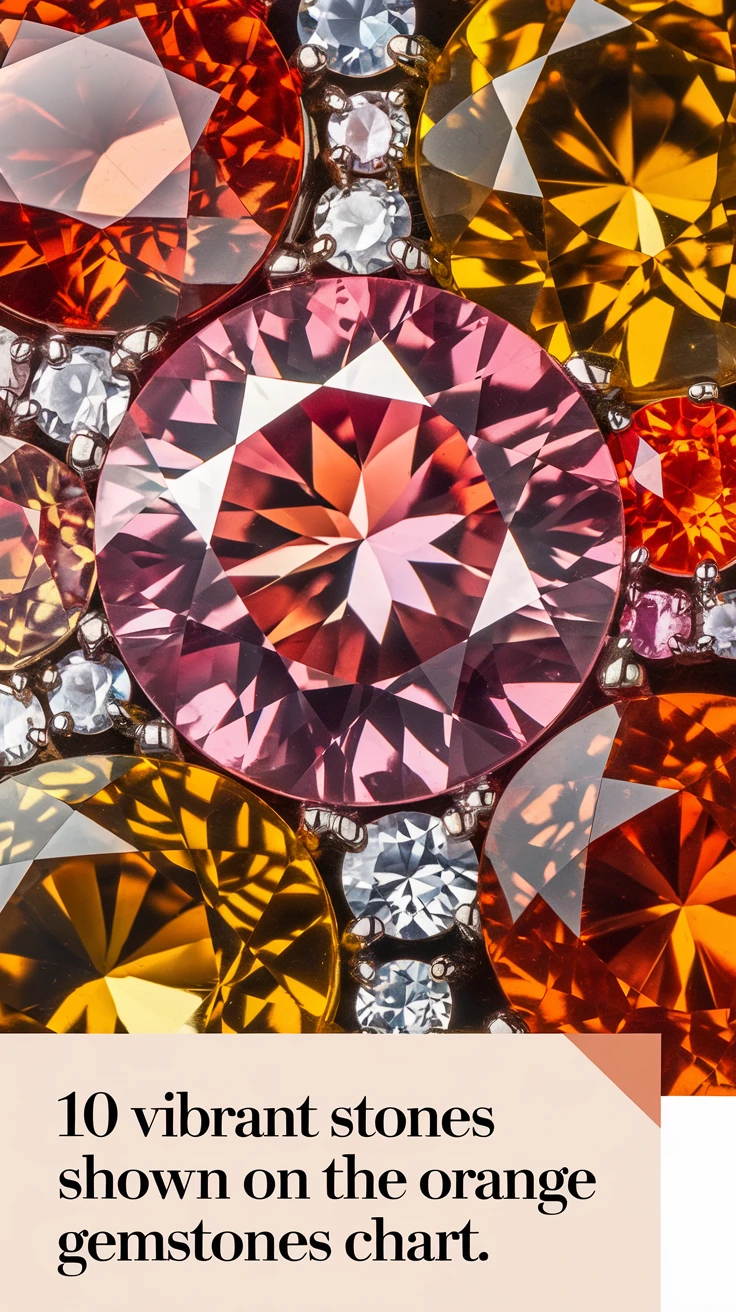
When it comes to the mesmerizing world of gemstones, orange varieties hold a special place with their warm, energetic, and striking appearance. These vibrant stones capture the essence of sunset skies and autumn leaves, making them increasingly popular in both jewelry and collections. From the rare and precious to the more accessible options, orange gemstones offer a unique combination of fire and elegance that sets them apart in the colorful spectrum of precious and semi-precious stones.
In this comprehensive guide, we’ll explore ten stunning orange gemstones that showcase nature’s ability to create extraordinary beauty. Whether you’re a seasoned collector, a jewelry enthusiast, or simply curious about these fascinating minerals, this orange gemstones chart will help you understand their unique characteristics, values, and appeal.
1. Fire Opal: Nature’s Living Flame
The Fire Opal stands as perhaps the most famous orange gemstone, celebrated for its intense, transparent-to-translucent body color that seems to glow from within. Primarily mined in Mexico, this remarkable stone captures the essence of a sunrise in its crystalline structure.
Key Characteristics:
– Hardness: 5.5-6.5 on the Mohs scale
– Origin: Mainly Mexico, with some deposits in Brazil and Australia
– Color Range: Yellow-orange to deep orange-red
– Transparency: Transparent to translucent
Price Range and Quality Factors:
| Quality | Price per Carat | Characteristics |
|---|---|---|
| Premium | $500-$1000+ | Vivid orange, high transparency, minimal inclusions |
| Fine | $200-$500 | Good color, some transparency, minor inclusions |
| Commercial | $50-$200 | Pale color or significant inclusions |
2. Orange Sapphire: Royal Radiance
Orange sapphires represent a rare and precious variety of corundum, sharing the same mineral family as rubies and blue sapphires. Their remarkable hardness and durability make them excellent choices for everyday wear.
Notable Features:
– Hardness: 9 on the Mohs scale
– Primary Sources: Sri Lanka, Tanzania, and Madagascar
– Color Variations: Light peachy orange to deep mandarin
– Crystal System: Hexagonal
Care Instructions:
– Clean with warm soapy water and a soft brush
– Avoid ultrasonic cleaners for treated stones
– Store separately to prevent scratching other gemstones
– Protect from sudden temperature changes
3. Spessartite Garnet: The Mandarin Marvel
Spessartite garnets, often called Mandarin garnets, display some of the most intense orange colors in the gemstone world. Their brilliant luster and high refractive index create exceptional sparkle.
Color Variations:
| Shade | Description | Value Factor |
|---|---|---|
| Pure Orange | Most valuable, resembling mandarin oranges | Highest |
| Reddish-Orange | Common in Nigerian specimens | Moderate |
| Yellowish-Orange | Often found in Namibian deposits | Variable |
4. Orange Zircon: The Brilliant Alternative
Natural zircon in orange hues offers exceptional brilliance and fire, often rivaling diamonds in their sparkle. These underappreciated gems provide excellent value for collectors and jewelry enthusiasts.
Properties:
– Hardness: 7.5 on the Mohs scale
– Origins: Cambodia, Sri Lanka, and Tanzania
– Brilliance: Very high
– Durability: Requires careful handling due to brittleness
5. Citrine: The Merchant’s Stone
Natural citrine, with its honey-to-amber orange hues, has been associated with prosperity and success throughout history. While most commercial citrine is heat-treated amethyst, natural specimens are highly valued.
Investment Value Points:
– Natural vs. Treated identification
– Color intensity evaluation
– Origin verification
– Size and cut quality assessment
6. Orange Imperial Topaz: The Royal Choice
Imperial topaz in orange shades represents one of the most valuable varieties of this classic gemstone. Its rarity and historical significance make it highly sought after by collectors.
Physical Characteristics:
– Perfect cleavage requires careful cutting
– Pleochroic properties showing different colors
– Typically free of inclusions
– Superior hardness of 8 on Mohs scale
7. Orange Tourmaline: The Rainbow Gem
Orange tourmaline, while less common than other tourmaline colors, offers unique charm and versatility. Its availability in various sizes makes it suitable for diverse jewelry applications.
Market Trends:
– Growing popularity in designer jewelry
– Increasing value for pure orange specimens
– Rising demand in Asian markets
– Strong appeal among young collectors
8. Amber: Ancient Solar Capsule
Though technically not a crystal, amber’s orange varieties have captivated humans for millennia. This fossilized tree resin often contains fascinating inclusions of ancient life.
Quality Factors:
– Clarity and transparency
– Color intensity
– Age and origin
– Presence of interesting inclusions
9. Orange Sphene (Titanite): The Rainbow Fire
Sphene, with its exceptional dispersion exceeding that of diamond, creates remarkable fire in orange specimens. This lesser-known gem offers unique optical properties.
Notable Characteristics:
– Extreme dispersion creating colorful flashes
– Typically small sizes
– Usually included
– Requires protective settings
10. Mandarin Quartz: Affordable Beauty
This accessible orange gemstone provides an excellent entry point for collectors interested in orange specimens. Its durability and availability make it perfect for everyday jewelry.
Value Considerations:
– Color intensity
– Clarity and transparency
– Size availability
– Treatment status
Conclusion
The world of orange gemstones offers something for every collector and jewelry enthusiast, from rare and precious specimens to more accessible options. Understanding these stones’ characteristics, values, and care requirements helps make informed decisions whether collecting or purchasing jewelry. Remember that proper care and storage will help maintain their beauty for generations to come.
Key Takeaways
- Orange gemstones vary significantly in hardness, durability, and value
- Natural specimens typically command higher prices than treated stones
- Proper care and storage are essential for maintaining gemstone quality
- Origin and treatment status significantly impact value
- Each orange gemstone offers unique optical properties and characteristics
Frequently Asked Questions
What is the most valuable orange gemstone?
High-quality orange sapphires and imperial topaz typically command the highest prices among orange gemstones, with exceptional specimens selling for thousands per carat.
How can I tell if an orange gemstone is natural or treated?
Professional gemological testing is the most reliable way to determine if a stone is natural or treated. However, working with reputable dealers and obtaining certificates can provide assurance.
Are orange gemstones more expensive than other colors?
The price depends more on the specific variety and quality than the color alone. Some orange gems like citrine are affordable, while others like orange sapphires can be very expensive.
How should I care for orange gemstones?
Most orange gemstones can be cleaned with warm soapy water and a soft brush. Avoid ultrasonic cleaners unless you’re certain about the stone’s stability, and store pieces separately to prevent scratching.
Where are orange gemstones typically found?
Orange gemstones come from various locations worldwide, with significant sources in Mexico, Sri Lanka, Brazil, and African countries like Tanzania and Madagascar.
Can orange gemstones fade over time?
Some orange gemstones, particularly certain treated stones, may fade with prolonged exposure to strong light. Natural stones typically maintain their color better.
What makes some orange gemstones more valuable than others?
Factors including rarity, durability, color intensity, clarity, and market demand all contribute to a gemstone’s value.
Are orange gemstones suitable for engagement rings?
Harder orange gemstones like sapphires (9 on Mohs scale) are excellent for engagement rings, while softer stones may be better suited for occasional wear.
How can I identify fake orange gemstones?
Working with certified gemologists and reputable dealers is the best way to avoid fake stones. Look for appropriate certifications and ask about any treatments or enhancements.
Do orange gemstones have any spiritual significance?
Many cultures associate orange gemstones with creativity, confidence, and positive energy. They’re often connected to solar energy and vitality in various spiritual traditions.

